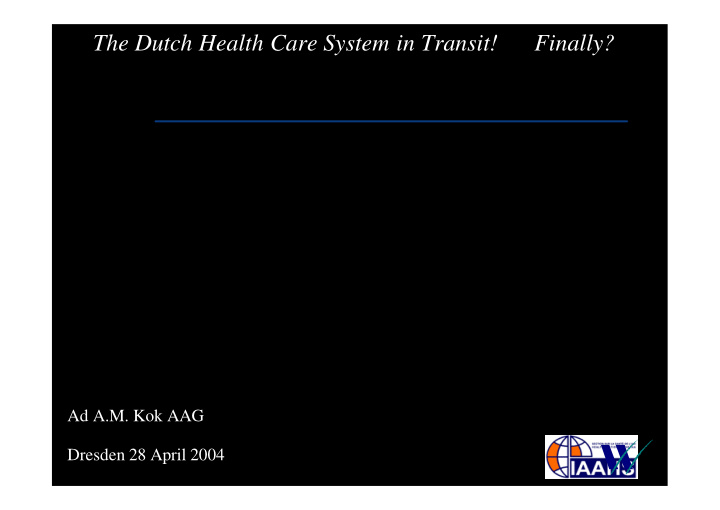



The Dutch Health Care System in Transit! Finally? Ad A.M. Kok AAG Dresden 28 April 2004 1
Outline of presentation Current system � Why the change ? � New Standard Insurance Cover � Coverage – Premium – Insurers – Cash-flows – Actuarial Challenges � 2
Current system Both public and private medical care � insurances Three compartments � ‘non-insurable’ risks: public / social security (AWBZ) 1. more common curative care – dual system: 2. low income levels : public (ZFW) high income levels : private supplementary care : private 3. 3
Use of Health Care Insurance According to type of insurance in 2nd compartment (January 2003) 3% Public (ZFW) Private 35% Balance 62% Source: Vektis 4
Total net expenditure 2002 € millions Public AWBZ (1st compartment) 18,536 ZFW (2nd compartment) 15,502 Private Supplementary next to ZFW (3rd compartment) 1,008 Private Insurances (2nd and 3rd compartment) 6,940 Total 41,985 Source: Vektis, CBS 5
Net expenditure 1st compartment Per sector (2002) 2% Care for mentally ill 18% Care for handicaped Care for the elderly, including homecare and nursing home 23% 57% Other Source: CVZ 6
Net expenditure 2nd and 3rd compartment Per sector (2002) 20% Hospitalization Specialist care Pharmaceuticals 6% General Practitioner 49% Other 18% Source: Vektis, CVZ 7% 7
Why change the system? Flaws current system: � Uncontrollable expenditure increase 1993: € 26.0 million 2003 (estimated): € 40.7 million � Unbalanced supply and demand (waiting lists) 8
Solution � More market, less government regulation � One system � Same incentives and interests for all parties 9
Earlier attempts Several earlier attempts to create one system: � Hendriks 1970’s � Dekker Committee late 1980’s � Simons 1990’s Current attempt seems successful Planned introduction: January 1 st 2006 10
But still … uncertainty Proposed design is currently under discussion in Parliament 11
New Standard Insurance Cover � Private insurance with public boundary conditions � Compulsory insurance � Compulsory acceptance � Premium differentiation based on age or health status prohibited � No-claim refund � Risk equalization between insurers 12
Coverage Transition Current situation New situation 1st compartment Revised AWBZ & Local Govt. 2nd compartment Standard Insurance Cover 3rd compartment Supplementary 13
Premium � Partly depending on income; partly nominal � Employer pays income-depended part � Self-employed pays both premium parts � Government pays for minors � Low incomes will get some tax relief 14
Premium (cont.) Income depending premium: � Set by government � Paid by employer � Put in fund and used for risk equalization Nominal premium: � Set by insurer (variable) � Paid by insured 15
Coverage Variations � New legislation will set out global terms of cover, but details are filled in by insurer � Both in kind and restitution system allowed � Different deductibles possible next to no-claim � Different covers depending on region possible � Supplementary cover next to Standard Insurance Cover 16
Insurers in new market � Insurers will compete on: - level of nominal premium - quality of bought-in care � Not all insurers can join in: - requirements - official admission by government 17
Opportunities private insurers � Insurers are allowed to make profit and distribute it to the shareholders � Supplementary cover � Insurer does not have to set up a contract with each healthcare supplier ? stronger position in negotiations � Risk equalisation ? ‘high risks’ not necessary unprofitable 18
Cash flow s Employer Income depended premium Risk Nominal premium Equalization Fund Supplementary premium Self employed Possibly Healthcare Insurance supplier Insured via Company insured employee Government (minors) 19
Undesirable behaviour � Insurer can fill in details Standard Insurance Cover ? risk selection � Large supplementary packages decrease mobility elderly and chronically ill 20
Actuarial challenges � Premium setting � Setting up a risk equalization system An equalization system already exists for current 2nd compartment public insurance (ZFW) � Reserving under a risk equalization system � Matching financial requirements Standard insurance with other developments 21
Other developments � New monitoring concepts Dutch Supervisor Three tests: Minimum, Solvency, Continuity � IFRS Phase I : Definition Insurance contract, Disclosure Phase II : Fair Value liabilities � Solvency II EU Solvency concepts 22
Time frame 2004 2005 2006 2007 2008 IFRS Phase I Solvency II FTK Standard Insurance IFRS Phase II 23
Conclusion � Standard Insurance Cover will be introduced probably (finally) � Plans are currently under discussion in Dutch Parliament � Private system with public boundary conditions � Free-market basis to decrease costs and to balance supply and demand � Introduction Standard Insurance Cover is not the only far-reaching development ahead 24
Recommend
More recommend